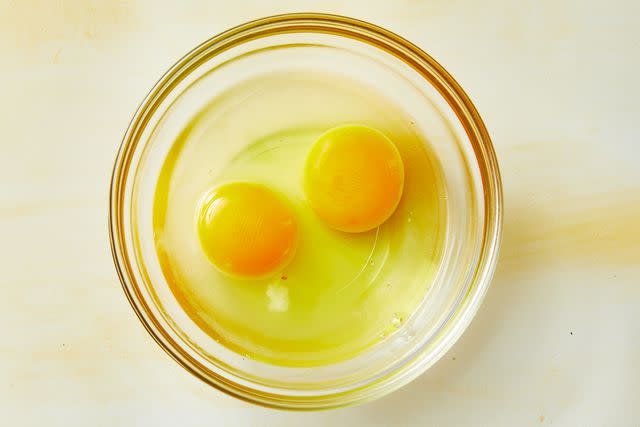How To Crack An Egg

For a good clean break, hit it where it is weakest.
Fact checked by Khara ScheppmannFact checked by Khara Scheppmann
Cracking an egg is one of the most basic things you will do when baking. This task also may entice a child into cooking; there are not too many opportunities to break something at home without getting into trouble.
However, once you start trying your hand at making cakes and pies for family dinners and church socials, you soon realize cracking eggs isn't all fun and games. Experienced chefs can crack, split, and drop an egg into a bowl with a couple of deft movements and using only one hand, but it's often a messy affair for the rest of us.
So, how do you crack an egg without breaking yolks or picking out eggshells? We have two methods to share and one common tip that will allow you to crack eggs with a clean break.

Caitlin Bensel, Food Styling: Torie Cox
Cracking Eggs On The Edge Of A Bowl
Cracking eggs on the edge of a bowl may be a popular method, but there are drawbacks:
If you don't get a sharp crack with the first whack, you will break the shell further when pulling it apart, pushing shell bits inside the egg and allowing any existing bacteria from the shell to come in contact with the yolks and white.
You can also easily puncture the yolk using this method.
Despite the drawbacks, I still prefer this method over cracking on a flat surface. My favorite method for cracking eggs, regardless of how many eggs are called for in the recipe (and especially if I am separating the yolks from the whites), is to crack one egg into a small, thin-edged bowl. Then, I transfer the egg to the main mixing bowl, repeating the process with each egg.
This way I can much more easily fish out errant eggshell pieces, and if one of the yolks break, I have only lost one egg, not all.
Pro Tip
Choose a bowl with a thin edge, such as a stainless steel mixing bowl. If you try to crack an egg on a wide-rimmed ceramic bowl, you are likely to crush the eggshell instead of cracking it.

Caitlin Bensel; Food Stylist: Torie Cox
Cracking Eggs On A Flat Surface
Do you prefer to crack eggs on a flat surface? If done correctly, you just need one assertive whack on the countertop. Then, using a thumb, make an indentation at the crack and pull the shell apart with both hands while holding it over a bowl.
Sounds easy enough, but if you don't get a solid crack as you try to pull the shell apart, you will encounter the same issues as cracking the egg on the edge of the bowl.
The key is to hold the egg lightly and give it a swift rap on the countertop. Too timid a rap, and you will have to hit it again. Too hard of a rap, and you crush the shell.
Related: The Right Way To Freeze Egg Whites And Yolks
The Secret To Perfectly Cracked Eggs
It seems the secret is not necessarily which method you use to crack the egg, but where you crack the egg.
It sounds cruel, but hit it where it is weakest: You need to apply the right amount of force to the "egg equator," or the center of the egg, to get a good, clean break.
If you simply want to whip up an omelet without getting shells in the bowl, use your favorite method to crack the egg, but always aim for the middle.
Related: How To Separate Egg Whites From Yolks
Frequently Asked Questions
How do you crack an egg with one hand?
Hold the egg (over a bowl) with your thumb near the middle of the egg and your pointer finger near the top, curling other fingers around the egg. Swiftly crack the egg against a surface or bowl, and use your thumb, pointer and middle fingers to pull apart the shell and release the egg into the bowl below.
Why shouldn't you crack eggs directly into a pan?
Little bits of eggshell, no matter how you crack an egg, can end up in the pan. And it will be much harder to fish a piece of shell out of a hot pan than if you had cracked the egg into a seperate bowl first.
How do I easily remove bits of eggshell from my cracked eggs?
Use a larger piece of eggshell to scoop out the tiny shell pieces. This method works a lot better than using a spoon or your fingers (which typically results in you chasing a tiny shard of shell around the bowl.)
For more Southern Living news, make sure to sign up for our newsletter!
Read the original article on Southern Living.